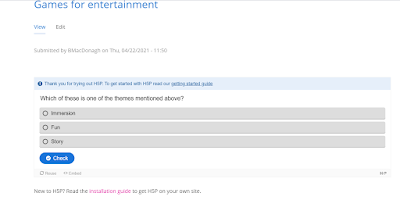READING GAME DESIGN
WHAT IS A GAME ANYWAY
In the paper "What is a game Anyway" it uses informal language to describe to me what a game can be and give me example. One such example that was given was "Three to Fifteen" the author explains how many players there can be, the objective, how progression works and how to win. The author then went on to explain critical vocabulary, which is essentially the describing of a game to people. Next they went on to what defined a game with a list of peoples different opinions on what that means a few examples are a game has “ends and means”: an objective, an outcome, and a set of rules to get there" by David Parlett another is "A game is an activity involving player decisions, seeking objectives within a “limiting context”" by Clark C. Abt.
THE ORGANIC NATURE OF GAME IDEATION
The next paper "The organic nature of game ideation" was written in a much more academic style, the paper starts by describing the idea generation on games and how game companies compete with each other and how brainstorming is a popular from of idea generation since the 1930s. The author goes on to talk about a few interview they had with game designers, the questions that were asked were in related to different approaches to coming up with ideas, there views on the structural parts of game ideas, and the role of game ideas in the production of games. It then goes on to describe the formal and informal approaches to idea creation. Near the end the author that through there interviews that mechanics aspects of a game are considered more impotent than the thematic aspects and that "game ideas work as a starting point for game production rather than as a fundamental element of the game itself ".
FOUR BASIC METHODS FOR GENERATING IDEAS
The finale piece of reading was a website on "Four Basic Methods for Generating Ideas", which describes the four different techniques for idea development. The first and most common being concentration in essence was "merely think until you have an idea" however it is more complex then that. The author goes on to discuses a biochemist believed that, to paraphrase the Vasiliev Ilya " thinking in a stationary atmosphere a person will always get the same ideas, but being in a changing atmosphere, a person will develop different ideas". Another technique is Brainstorming where people come up with different ideas and the group selects the best one. The third is s.c.a.m.p.e.r which is an acronym for substitute, combine, adapt, modify, put, eliminate and reverse. The fourth and finale one is the Ramsey method, which is supposed to be most difficult. the way the author describes it is you acquire as mush information on a top as you can then begin to look for hidden connotations until the game concept is collected from these pieces. A few examples that are given of games made using this method are American McGee's Grimm, American McGee's Alice and the squeal Alice: Madness Returns






Hi Bernard! I enjoyed reading your summary of what game design is. I can't wait to see what your game looks like in the near future. I've been finding it really helpful to brainstorm for idea generation after reading "the organic nature of game ideation" It's really helpful especially when it comes to CDM as creativity can always come and go. I can't wait to see where your creativity takes you. - Anna Zurawska
ReplyDeleteHey Bernard, I enjoyed reading what you think game design is. I'm looking forward to seeing what your game turns out like over the coming weeks. I found that it was easier to brainstorm ideas after reading the organic nature of game ideation, is very helpful and especially when it comes to the CDM course because all modules require creativity at some level. Hopefully your creativity takes you where you want to go. Good luck!!!
ReplyDelete